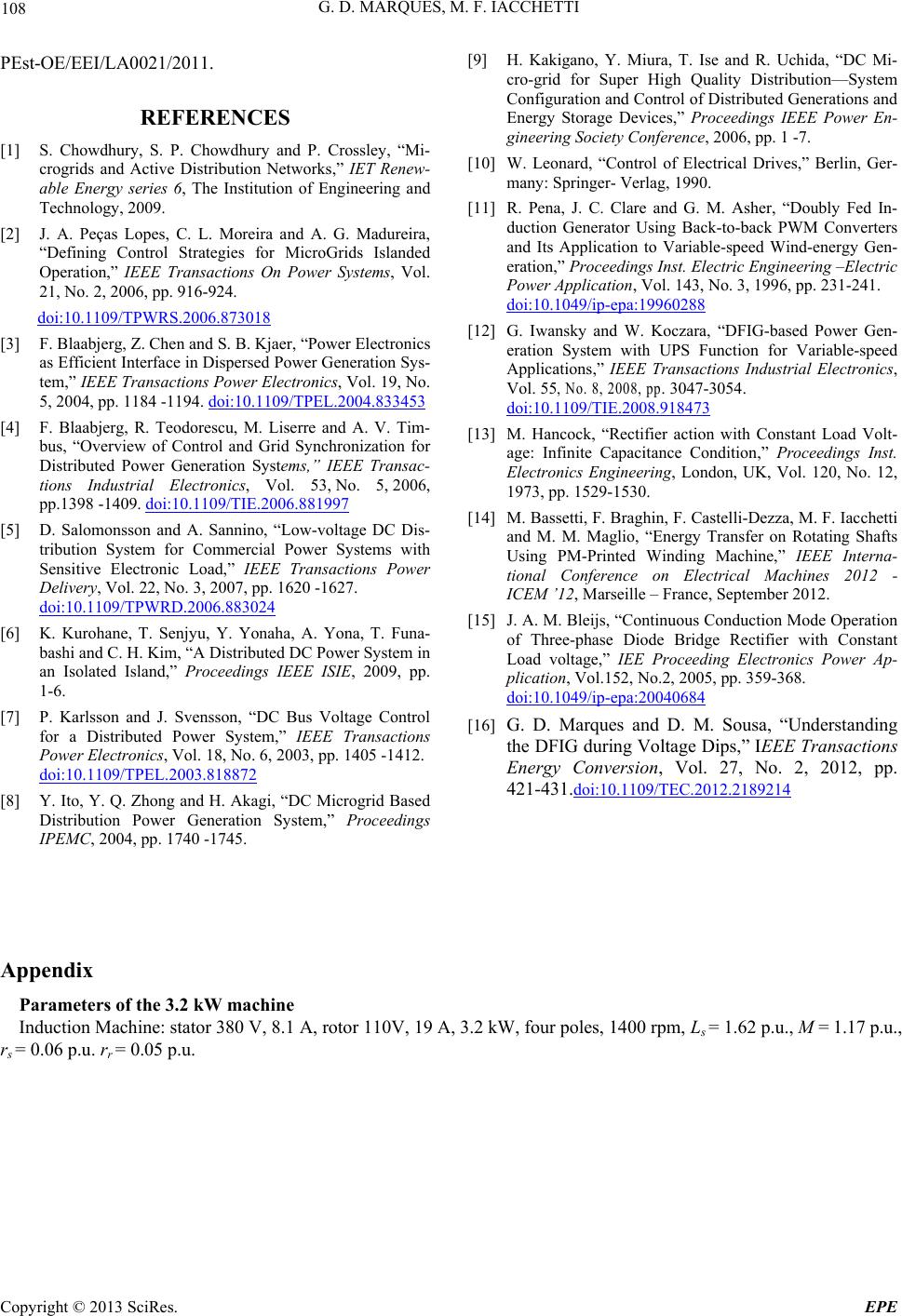
G. D. MARQUES, M. F. IACCHETTI
Copyright © 2013 SciRes. EPE
108
PEst-OE/EEI/LA0021/2011.
REFERENCES
[1] S. Chowdhury, S. P. Chowdhury and P. Crossley, “Mi-
crogrids and Active Distribution Networks,” IET Renew-
able Energy series 6, The Institution of Engineering and
Technology, 2009.
[2] J. A. Peças Lopes, C. L. Moreira and A. G. Madureira,
“Defining Control Strategies for MicroGrids Islanded
Operation,” IEEE Transactions On Power Systems, Vol.
21, No. 2, 2006, pp. 916-924.
doi:10.1109/TPWRS.2006.873018
[3] F. Blaabjerg, Z. Chen and S. B. Kjaer, “Power Electronics
as Efficient Interface in Dispersed Power Generation Sys-
tem,” IEEE Transactions Power Electronics, Vol. 19, No.
5, 2004, pp. 1184 -1194. doi:10.1109/TPEL.2004.833453
[4] F. Blaabjerg, R. Teodorescu, M. Liserre and A. V. Tim-
bus, “Overview of Control and Grid Synchronization for
Distributed Power Generation Systems,” IEEE Transac-
tions Industrial Electronics, Vol. 53, No. 5, 2006,
pp.1398 -1409. doi:10.1109/TIE.2006.881997
[5] D. Salomonsson and A. Sannino, “Low-voltage DC Dis-
tribution System for Commercial Power Systems with
Sensitive Electronic Load,” IEEE Transactions Power
Delivery, Vol. 22, No. 3, 2007, pp. 1620 -1627.
doi:10.1109/TPWRD.2006.883024
[6] K. Kurohane, T. Senjyu, Y. Yonaha, A. Yona, T. Funa-
bashi and C. H. Kim, “A Distributed DC Power System in
an Isolated Island,” Proceedings IEEE ISIE, 2009, pp.
1-6.
[7] P. Karlsson and J. Svensson, “DC Bus Voltage Control
for a Distributed Power System,” IEEE Transactions
Power Electronics, Vol. 18, No. 6, 2003, pp. 1405 -1412.
doi:10.1109/TPEL.2003.818872
[8] Y. Ito, Y. Q. Zhong and H. Akagi, “DC Microgrid Based
Distribution Power Generation System,” Proceedings
IPEMC, 2004, pp. 1740 -1745.
[9] H. Kakigano, Y. Miura, T. Ise and R. Uchida, “DC Mi-
cro-grid for Super High Quality Distribution—System
Configuration and Control of Distributed Generations and
Energy Storage Devices,” Proceedings IEEE Power En-
gineering Society Conference, 2006, pp. 1 -7.
[10] W. Leonard, “Control of Electrical Drives,” Berlin, Ger-
many: Springer- Verlag, 1990.
[11] R. Pena, J. C. Clare and G. M. Asher, “Doubly Fed In-
duction Generator Using Back-to-back PWM Converters
and Its Application to Variable-speed Wind-energy Gen-
eration,” Proceedings Inst. Electric Engineering –Electric
Power Application, Vol. 143, No. 3, 1996, pp. 231-241.
doi:10.1049/ip-epa:19960288
[12] G. Iwansky and W. Koczara, “DFIG-based Power Gen-
eration System with UPS Function for Variable-speed
Applications,” IEEE Transactions Industrial Electronics,
Vol. 55
, No. 8, 2008, pp
. 3047-3054.
doi:10.1109/TIE.2008.918473
[13] M. Hancock, “Rectifier action with Constant Load Volt-
age: Infinite Capacitance Condition,” Proceedings Inst.
Electronics Engineering, London, UK, Vol. 120, No. 12,
1973, pp. 1529-1530.
[14] M. Bassetti, F. Braghin, F. Castelli-Dezza, M. F. Iacchetti
and M. M. Maglio, “Energy Transfer on Rotating Shafts
Using PM-Printed Winding Machine,” IEEE Interna-
tional Conference on Electrical Machines 2012 -
ICEM ’12, Marseille – France, September 2012.
[15] J. A. M. Bleijs, “Continuous Conduction Mode Operation
of Three-phase Diode Bridge Rectifier with Constant
Load voltage,” IEE Proceeding Electronics Power Ap-
plication, Vol.152, No.2, 2005, pp. 359-368.
doi:10.1049/ip-epa:20040684
[16] G. D. Marques and D. M. Sousa, “Understanding
the DFIG during Voltage Dips,” IEEE Transactions
Energy Conversion, Vol. 27, No. 2, 2012, pp.
421-431.doi:10.1109/TEC.2012.2189214
Appendix
Parameters of the 3.2 kW machine
Induction Machine: stator 380 V, 8.1 A, ro tor 110V, 19 A, 3.2 kW, four poles, 1400 rpm, Ls = 1.62 p.u., M = 1.17 p. u.,
rs = 0.06 p.u. rr = 0.05 p.u.